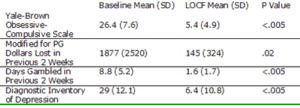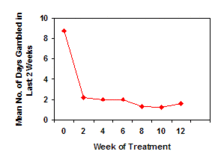The WAGER Vol. 7(23) – Treatment for Pathological Gambling: A Pharmacological Approach
Researchers have suggested that pathological gambling (PG) is an obsessive compulsive spectrum disorder (WAGER 4(19)). Proponents hold that disorders such as trichotillomania, PG, Tourette’s syndrome, and obsessive compulsive disorder (OCD) can be located on a spectrum characterized by compulsion and impulsivity. If this is the case, medications that are effective for some spectrum disorders might be effective for others. This week the WAGER reviews a recent study that evaluated the effectiveness of the selective serotonin reuptake inhibitor (SSRI) citalopram, commonly used to treat OCD, in the treatment of pathological gambling (Zimmerman, Breen, & Posternak, 2002).
Zimmerman, Breen and Posternak recruited potential study participants through advertisements in a local newspaper and enrolled 20 who met DSM-IV criteria for pathological gambling. At baseline, the patients participated in a clinician-guided interview and completed several self-administered questionnaires assessing gambling behavior, depression, and demographics1. Clinicians initially prescribed patients citalopram in an open-label protocol2 beginning with 10 mg/day. Depending on their response and side effects, clinicians could prescribe patients up to 60mg/day. For three months, patients returned at 2-week intervals for assessment. Of the 20 patients enrolled in the study, five did not return for the initial follow-up; Zimmerman et al. excluded these participants from the analysis. Only nine of the remaining 15 patients completed the entire study. For all 15 participants, researchers used the data from the last completed follow-up in analyses of later observation periods (i.e. last-observation-carriedforward method (LOCF)). Paired t-tests compared pre- and posttreatment scores (Table 1) on several dimensions.
Table 1. Change in Symptom Domains in Pathological Gamblers After Treatment with Citalopram (N=15)

Zimmerman, et al. found that citalopram patients improved on all outcome measures during the course of the study; significant improvements included fewer days gambled in the past two weeks, lower scores on an obsessive-compulsive scale modified to assess PG, and the severity of depression. Gambling behavior, as measured by mean number of days gambled in the past two weeks, decreased sharply at the first follow-up and stayed low throughout the study period (Figure 1). The researchers compared the outcomes of the patients with (N = 8) and without (N = 7) a major depressive disorder at baseline. Both groups showed comparable improvements in gambling indicating that citalopram had an effect on gambling behavior in addition to its effect on depression.
Figure 1. Number of Days Gambled During 3-Month Course of Treatment with Citalopram for the 15 patients who completed part or all of the study (The six that dropped out did so after 2 weeks (N=1), 4 weeks (N=1), 6 weeks (N=3) and 8 weeks (N=1) (Adapted from Zimmerman et al. (2002))
Although the results are encouraging, the study was limited in a number of ways. Limitations included the poor retention rate, the lack of an adequate control group, and the use of the LOCF data analysis method. Specifically, the poor retention rate might suggest that citalopram is somewhat aversive in nature which could reduce the overall impact of this treatment. This limitation, however, might be less severe than the combined effect of the lack of a control group and the use of the LOCF method. The lack of an adequate control group fails to preclude the possibility that non-specific factors associated with treatment (i.e. a placebo effect) played a role in the patients’ improvement. Further, Zimmerman et al. observed a large treatment effect by the first follow-up; however, it is unlikely that citalopram would yield its effect so rapidly, which suggests a placebo effect. Using the LOCF method of analysis worsens our ability to understand follow-up results because those who did not maintain their initial dramatic improvement might have been more likely to drop out. Any recidivism in this group would not be part of the study outcomes.
Clinical trials are an essential step in determining the efficacy and impact of pharmacotherapies for PG. Zimmerman et al. show that citalopram is a promising new treatment for pathological gambling; this work suggests that citalopram warrants further evaluation using more rigorous double-blind, placebo-controlled studies. As research builds in the area of pharmacotherapies, scientists and clinicians will develop a more well-rounded understanding of pathological gambling and best practices for treatment.
Comments on this article can be addressed to Rachel Kidman.
Notes
1. Structured Clinical Interview for DSM-IV (SCID), South Oaks Gambling Screen (SOGS), the Obsessive-Compulsive Scale modified for pathological gambling (OCDS-PG), the Diagnostic Inventory for Depression (DID), Clinical Global Impressions of Improvement in Gambling Behavior.
2. In open-label trials, the patient and doctor know what drug the doctor is prescribing and no placebo conditions are used.
References
Zimmerman, M., Breen, R., & Posternak, M. (2002). An Open-Label Study of Citalopram in the Treatment of Pathological Gambling. Journal of Clinical Psychiatry, 63(1), 44-48.
